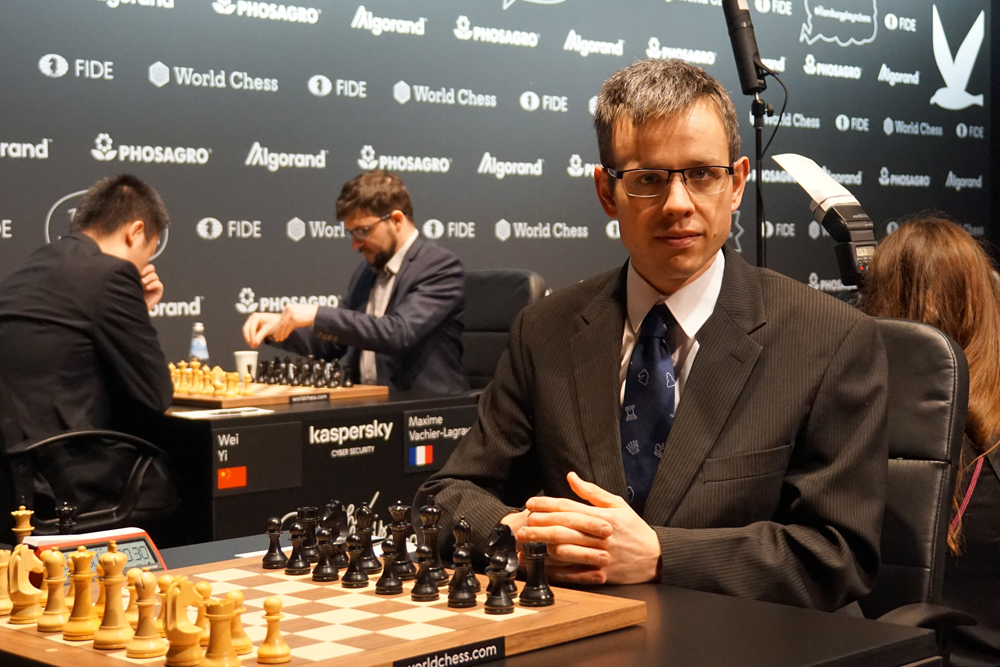


Ian Nepomniachtchi is a long-standing member of the chess elite and one of the players that could conceivably put up a fight against Magnus Carlsen in a World Championship match. He is also the highest-rated player from Russia and the world number six at the moment. However, after having won the first leg of the Grand Prix in Moscow — thus becoming one of the favourites to end up atop the standings — he was eliminated in the first round of the third leg in Hamburg. Nevertheless, he still has chances to qualify to the Candidates, as a good result at the final stage in Jerusalem next month might just be enough to get the coveted prize.
The player who knocked Nepomniachtchi out was Poland's number one Jan-Krzysztof Duda. The 21-year-old won game one and found himself defending an inferior queenless position right out of the opening on Wednesday:
Black's light-squared bishop is quite restricted on d7, while White has one of his rooks already activated on b4. Here began the long grind. Nepomniachtchi kept building up the pressure until gaining a pawn right before the time control, and a series of simplifications led to a rook endgame with White having three connected pawns against Black's pair of doubled pawns on the same flank.
This is the position after 51 moves. We certainly cannot blame Nepomniachtchi for a lack of trying, as he kept looking for ways to provoke a mistake by his opponent until move 132, when the draw that gave Duda match victory was finally signed.
Jan-Krysztof Duda got a 1½:½ victory over Ian Nepomniachtchi | Photo: Nadja Wittmann
Another very active elite player who left the tournament early on is Hikaru Nakamura. The winner of last year's Grand Chess Tour did not have a great 2019 and missed what probably was his last realistic chance to reach the Candidates last month at the Grand Swiss. For a second GP event in a row, he was paired up against Veselin Topalov, and he was knocked out by the Bulgarian on both occasions.
Nakamura later declared that he hoped his opponent would play 1.e4, but against Topalov's 1.d4 he went for a tame Queen's Gambit Accepted, which both players agreed could have been drawn more quickly had Topalov exchanged queens early on. The player from Ruse, however, tried his chances and even won a pawn.
Given the match situation, White agreed to split the point in the diagrammed position. Nakamura explained:
I always felt like I was one tempo away — if I had one more move I could just be clearly better with the two bishops, but the extra tempo just wasn't there.
Veselin Topalov eliminated Hikaru Nakamura for a second time | Photo: Nadja Wittmann
Peter Svidler and Maxime Vachier-Lagrave also signed draws from comfortable positions to eliminate Pentala Harikrishna and Wei Yi respectively. While Svidler is pretty much out of contention in the race to reach the Candidates, Vachier-Lagrave is one of the front-runners in said pursuit — the French GM was the runner-up in Riga and will be playing in Jerusalem next month.
The rematch game between 'MVL' and Wei Yi was yet another Sicilian Najdorf — not a surprise, given the players' track records — and once again Vachier-Lagrave showed superior preparation. Well aware of the fact that he could only get in trouble if he kept going, the Chinese star agreed to go for a triple repetition:
The game came to an end after 24...♛f1+ 25.♖d1 ♛f6 26.♖d6 ♛f1+, etc. But does Vachier-Lagrave feel pressure to get one of the Candidates spots at all costs? He responded:
There's pressure to some extent because it would be a huge disappointment not to qualify [to] the Candidates, but at the same time I have two Grand Prix [events] to play and I have experience in this situation (smiles), so I don't think it affects me so much.
When he referred to his 'experience in this situation', he was talking about the fact that he barely missed on qualifying to the previous Candidates tournament — he was eliminated by Levon Aronian in a nail-biting semi-final match at the 2017 World Cup, much like this year against Teimour Radjabov.
Top seed Maxime Vachier-Lagrave | Photo: Nadja Wittmann
Talking about Radjabov, the Azerbaijani signed a second quick draw to take his match-up against Daniil Dubov to tiebreaks — in the rematch game, the Russian tried the rarely seen Italian Gambit with White, but nonetheless split the point after his opponent proved he knows how to face this sortie.
Another short draw was seen in Alexander Grischuk versus Radoslaw Wojtaszek. The players had played a tension-packed game on Tuesday, which prompted the ever-entertaining Grischuk to declare:
I think we should not spoil the spectators. Yesterday they had enough.
Clearly Wojtaszek was better prepared than the Russian. Grischuk explained:
Objectively it was because I was playing against [the] computer. I mean, it was clearly [...] Radoslaw's preparation, and I'm not enough of a dreamer to think I'm going to outplay the computer.
A well-known opening expert — Radoslaw Wojtaszek | Photo: Nadja Wittmann
The remaining two draws were longer affairs, albeit of very different nature. Nikita Vitiugov and David Navara played a balanced game throughout until Navara surprisingly got himself in trouble in a clearly equal endgame — fortunately for him, he remembered how to draw that position from a game he had played against Ding Liren at the 2018 Olympiad.
In Yu Yangyi versus Dmitry Jakovenko, on the other hand, the former missed a huge chance to advance to the quarter-finals without needing tiebreaks. Jakovenko lost a pawn early in the game, and White eventually simplified into a won knight endgame:
The Chinese could not convert from this position with White, which his rival described as 'a miracle'. Jakovenko added: "It took several mistakes from my opponent to save the game".
Yu Yangyi could not convert against Dmitry Jakovenko | Photo: Nadja Wittmann
Commentary by GM Evgeny Miroshnichenko